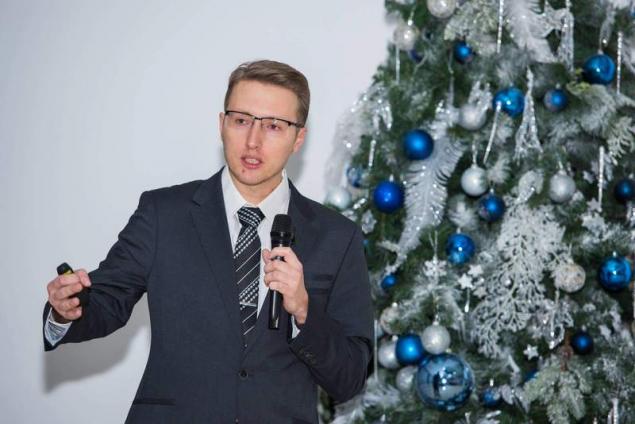Experimentally confirmed the birth of a new family of substances or Square daughter of graphene
 Bashny.Net
Bashny.Net
World's first experimentally obtained representative of a new family of two-dimensional substances – oxide of copper. It has already demonstrated its creators some unusual properties that can not only expand the field for experiments with graphene, but also set a new direction in microelectronics. The article is about the achievement of scientists of nust "MISIS", FSBI TISNCM, ibhf wounds and their foreign colleagues from the Japanese Institute NIMS was published in the prestigious journal NanoScale.

Pavel Sorokin (centre) at the presentation of the Scopus Award Russia-2015
An international group of physicists predicted and experimentally confirmed the existence of a new family of inorganic compounds. As the head of the theoretical part of the work, the head of the infrastructure project "Theoretical materials science of nanostructures", leading researcher of the laboratory "Inorganic nanomaterials" nust "MISIS" Prof. mathematical Sciences Pavel B. Sorokin, we are talking about the world's first two dimensional material with a square lattice of the oxide of copper.
The creation of a new two-dimensional materials – materials consisting of layers one atom thick is one of the most promising areas of modern materials science. From the receipt in 2004 of graphene, the first two-dimensional material – scientists worldwide are exploring its features, trying to combine it with other materials to obtain new properties.
Synthesis of a new family of substances, the researchers conducted, studying the different properties of graphene. Therefore, the two-dimensional Islands of copper oxide situated on graphene-based. According to Dr. Sorokin, synthesis on a substrate of graphene is so far the only real opportunity to get these two-dimensional materials. However, with the development of technology, this limitation can be overcome, said the scientist.

The "Christmas lectures" at nust "MISIS" Dr. Sorokin lecture "down There is full of places and this place has a lot of interesting. News a two-dimensional world."
Unlike graphene, which is formed with a hexagonal "honeycomb", a two-dimensional copper oxide has a square crystal lattice. "Until now, scientists were able to synthesize the materials with hexagonal lattice, for example, various derivatives of graphene or boron nitride, says Dr. Sorokin. – Flat square metal grating is unstable, however, the compound of copper with oxygen and stabilized her."
The used method opens wide possibilities for the synthesis of a new family of materials." In fact, scientists were able to achieve "self-Assembly" two-dimensional copper oxide on graphene. To create a new substance, the experimenters from the Institute NIMS (Japan) laid siege to partially oxidized graphene copper atoms from the gas phase. Then the heating system has led to the fact that the atoms of oxygen and copper regrouped in the new structure.

All the features of the new material have to study for a long time, but something about the properties of two-dimensional copper oxide we can say now. One of the unusual properties of the new material, predicted by Russian physicists Pavel Sorokin and Dmitry Kvashnin was the antiferromagnetism (low magnetization), the copper oxide does not show under any circumstances.
Antiferromagnets are very promising materials from the point of view of microelectronics. To record one bit of information in the antiferromagnet, just 12 atoms of its surface, whereas existing technology used to record one bit of hundreds of thousands of atoms.
There is another consequence of the new experiment. "Our discovery has shown the possibility of a new application of graphene as the basis for the Assembly of various substances, says Dr. Sorokin. – And not only of separate individual materials, but also two-dimensional layered heterostructures. In the present experiment, the graphene formed a new monolayer structure with a set of unique properties that we have yet to examine in detail".
Help nust "MISIS": Sorokin Pavel Borisovich, doctor of physico-mathematical Sciences. Head of infrastructure project "Theoretical materials science of nanostructures" at nust "MISIS", senior researcher of the laboratory "Inorganic nanomaterials".
Research interests: atomistic simulation, nanostructures, nanotechnology, quantum-chemical calculations from first principles, density function theory methods, empirical methods of calculation.
Prize of the Russian club of the European Academy (Academia Europaea) for young scientists in physics, prize Scopus Award Russia-2015. More than 60 publications in international journals, including Nature Physics, Nature Communications, Nano Letters, ACS Nano, J. Phys. Chem. Lett. and others. published
P. S. And remember, only by changing their consumption — together we change the world! ©
Source: geektimes.ru/company/misis/blog/287190/

Pavel Sorokin (centre) at the presentation of the Scopus Award Russia-2015
An international group of physicists predicted and experimentally confirmed the existence of a new family of inorganic compounds. As the head of the theoretical part of the work, the head of the infrastructure project "Theoretical materials science of nanostructures", leading researcher of the laboratory "Inorganic nanomaterials" nust "MISIS" Prof. mathematical Sciences Pavel B. Sorokin, we are talking about the world's first two dimensional material with a square lattice of the oxide of copper.
The creation of a new two-dimensional materials – materials consisting of layers one atom thick is one of the most promising areas of modern materials science. From the receipt in 2004 of graphene, the first two-dimensional material – scientists worldwide are exploring its features, trying to combine it with other materials to obtain new properties.
Synthesis of a new family of substances, the researchers conducted, studying the different properties of graphene. Therefore, the two-dimensional Islands of copper oxide situated on graphene-based. According to Dr. Sorokin, synthesis on a substrate of graphene is so far the only real opportunity to get these two-dimensional materials. However, with the development of technology, this limitation can be overcome, said the scientist.

The "Christmas lectures" at nust "MISIS" Dr. Sorokin lecture "down There is full of places and this place has a lot of interesting. News a two-dimensional world."
Unlike graphene, which is formed with a hexagonal "honeycomb", a two-dimensional copper oxide has a square crystal lattice. "Until now, scientists were able to synthesize the materials with hexagonal lattice, for example, various derivatives of graphene or boron nitride, says Dr. Sorokin. – Flat square metal grating is unstable, however, the compound of copper with oxygen and stabilized her."
The used method opens wide possibilities for the synthesis of a new family of materials." In fact, scientists were able to achieve "self-Assembly" two-dimensional copper oxide on graphene. To create a new substance, the experimenters from the Institute NIMS (Japan) laid siege to partially oxidized graphene copper atoms from the gas phase. Then the heating system has led to the fact that the atoms of oxygen and copper regrouped in the new structure.

All the features of the new material have to study for a long time, but something about the properties of two-dimensional copper oxide we can say now. One of the unusual properties of the new material, predicted by Russian physicists Pavel Sorokin and Dmitry Kvashnin was the antiferromagnetism (low magnetization), the copper oxide does not show under any circumstances.
Antiferromagnets are very promising materials from the point of view of microelectronics. To record one bit of information in the antiferromagnet, just 12 atoms of its surface, whereas existing technology used to record one bit of hundreds of thousands of atoms.
There is another consequence of the new experiment. "Our discovery has shown the possibility of a new application of graphene as the basis for the Assembly of various substances, says Dr. Sorokin. – And not only of separate individual materials, but also two-dimensional layered heterostructures. In the present experiment, the graphene formed a new monolayer structure with a set of unique properties that we have yet to examine in detail".
Help nust "MISIS": Sorokin Pavel Borisovich, doctor of physico-mathematical Sciences. Head of infrastructure project "Theoretical materials science of nanostructures" at nust "MISIS", senior researcher of the laboratory "Inorganic nanomaterials".
Research interests: atomistic simulation, nanostructures, nanotechnology, quantum-chemical calculations from first principles, density function theory methods, empirical methods of calculation.
Prize of the Russian club of the European Academy (Academia Europaea) for young scientists in physics, prize Scopus Award Russia-2015. More than 60 publications in international journals, including Nature Physics, Nature Communications, Nano Letters, ACS Nano, J. Phys. Chem. Lett. and others. published
P. S. And remember, only by changing their consumption — together we change the world! ©
Source: geektimes.ru/company/misis/blog/287190/
Tags
See also
Precious stones and not very
Intel introduced a new family of server chips
Happy Birthday, Star. Scientists have 18 years of watching the birth of the New World
These people are capable of it, what others can only dream of. 5 superheroes of our time!
How to prolong youth and aging - a personal choice!
15 unusual school, which only steeper Hogwarts
Stanley Milgram: what is the measure of "obedience" inherent in man
10 possible forms of life
The discovery of massless particles can seriously speed up electronics
















